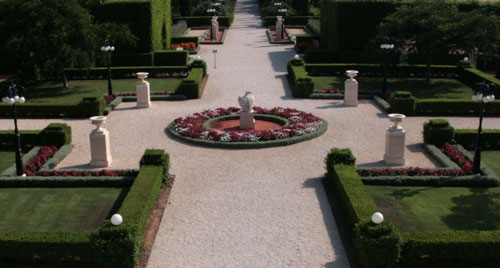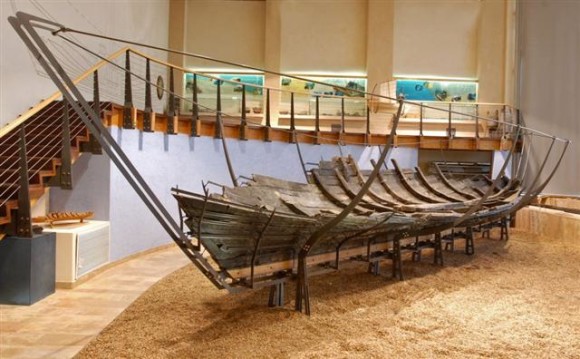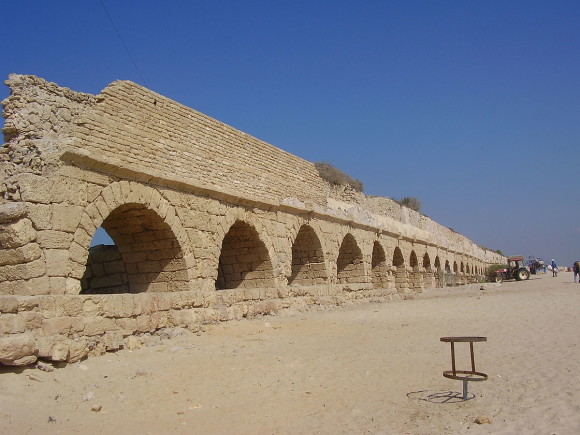Last weekend we had a trip to a series of varied, but interesting, locations. I found myself unable to walk the distances necessary at some of the sites, but that did not mean my trip was any less enjoyable.
 First stop was right here in Akko, at the Bahá’í Shrine. If anyone is at all familiar with Bahá’í locations, it is probably with the shrine in Haifa dedicated to the Báb, founder of the Bábí faith and forerunner of the Bahá’í faith. The Bahá’í faith, begun by the Bahá’u’lláh, a follower of the Báb, in Persia during the 1800s, is a world religion based on universal acceptance of all religions as valid and a belief that all religions believe in the same divinity. Bahá’u’lláh, unlike the Báb who was executed in Persia, was simply exiled to the Ottoman Empire. He settled in Akko, which was part of the Ottoman Empire at the time. He was also arrested and imprisoned for more than 15 years in the Akko prison and spent the rest of his life under house arrest here, all because he proposed a new religion. So Akko is the holiest place in the world for a member of the Bahá’í faith and there are many Bahá’í followers in Akko.
First stop was right here in Akko, at the Bahá’í Shrine. If anyone is at all familiar with Bahá’í locations, it is probably with the shrine in Haifa dedicated to the Báb, founder of the Bábí faith and forerunner of the Bahá’í faith. The Bahá’í faith, begun by the Bahá’u’lláh, a follower of the Báb, in Persia during the 1800s, is a world religion based on universal acceptance of all religions as valid and a belief that all religions believe in the same divinity. Bahá’u’lláh, unlike the Báb who was executed in Persia, was simply exiled to the Ottoman Empire. He settled in Akko, which was part of the Ottoman Empire at the time. He was also arrested and imprisoned for more than 15 years in the Akko prison and spent the rest of his life under house arrest here, all because he proposed a new religion. So Akko is the holiest place in the world for a member of the Bahá’í faith and there are many Bahá’í followers in Akko.
The shrine, as are all Bahá’í shrines, is a glorious mix of blooming flowers and trees, greenery and stone paths. The gardens are exquisite, breathtaking and contemplative. Unfortunately, I can’t tell you what the shrine looks like. I never got there. From the entrance into the outer gardens was a short walk, but then there was a very long walk down a pure white gravel path to the inner garden and the shrine. I began the walk, but got half way when I realized that if I went all the way, I would have a hard time walking back, gravel underfoot and cane not being a good combination. So, I turned around and walked back to where a guard was standing near a stone bench. I asked in Hebrew if I could sit there and wait, but he didn’t understand me. Then he asked, “Do you speak English?” I repeated in English and he said yes, I could sit. There were very few visitors and not much for him to do. We began to chat.
He is from Fiji and a member of the Bahá’í faith. He is spending a year of service in Akko at the shrine. In Fiji, he trained as an electrician and worked for a time, but when his mother died, he decided to fulfill her lifelong wish, which was to come to Akko to serve at the Shrine. At about 26 or 27 he has a sweet, shy, gap-toothed smile. He would like to study more in Australia, because they use the same electrical regulations as Fiji. Finally, the rest of the group appeared and I said goodbye.
 Next we went to the Hecht Museum at the University of Haifa. I’ve been there before and especially like the Ma’agan Mikhael shipwreck exhibit, the partial reconstruction of a 2,400-year-old merchant ship, but they also have no benches or chairs to sit on in the museum. After about 30 minutes I went outside to sit on one of the concrete benches. Our bus driver asked if I wanted to sit on the bus and I said it was too nice with the breeze to go inside. Then he asked if I wanted coffee. I said yes. He took a small propane tank out from under the bus, set it up in the empty luggage area, put a small metal finjan with water on the burner. After the water boiled, he put some spoons of powdered ground coffee in and let it just boil a second time. He poured me some in a paper cup and he had the same. We chatted for a while until we were done, and then he went back in the bus and I went back to my bench.
Next we went to the Hecht Museum at the University of Haifa. I’ve been there before and especially like the Ma’agan Mikhael shipwreck exhibit, the partial reconstruction of a 2,400-year-old merchant ship, but they also have no benches or chairs to sit on in the museum. After about 30 minutes I went outside to sit on one of the concrete benches. Our bus driver asked if I wanted to sit on the bus and I said it was too nice with the breeze to go inside. Then he asked if I wanted coffee. I said yes. He took a small propane tank out from under the bus, set it up in the empty luggage area, put a small metal finjan with water on the burner. After the water boiled, he put some spoons of powdered ground coffee in and let it just boil a second time. He poured me some in a paper cup and he had the same. We chatted for a while until we were done, and then he went back in the bus and I went back to my bench.
Eventually, the rest of the group exited the museum and we went to the Mount Carmel Caves, a UNESCO World Heritage Site. Excavated originally in the 1920s and 1930s, one cave contained the complete skeleton of a Neandertal, while another contained remains of early modern humans. I’ve been there before and the trek up was a bit more than I could handle, so I remained behind and watched the people, most of whom were going hiking on the surrounding trails and not visiting the caves.
Finally, we arrived in Caesarea, a lovely seaside resort city that houses the ruins of a city first built by Herod the Great and occupied during Byzantine and Crusader times and conquered by the Mamluks in the 13th century. Here is a city with something for everyone, a Roman theater, hippodrome, palaces and temple. Our first stop was the Bird Mosaic, the only visible part of a 6th-century palace. If the mosaic is an indication of what the palace was like, it was certainly opulent.
I knew that the rest of the tour included massive amounts of walking, so I headed for the restaurant area and with diet Coke in hand, people-watched. It was a lovely day with a breeze off the Mediterranean, but still hot enough to want some shade. Eventually, the group reappeared for their free time and I joined them. We then walked through the ruins for a short time to the North gate.

Our final stop was at the aqueduct, where some chose to explore the remaining arches, while others took a dip in the sea. The salty water soon had one of us mimicking a racoon with eye makeup encircling her eyes. The teasing was all in fun.
We headed off back to Akko happy, tired and somewhat salty. I know that others in the group felt bad that I didn’t get to do all the things they did, but, in a way, I had equal experiences meeting people and watching people. It was a good day.
